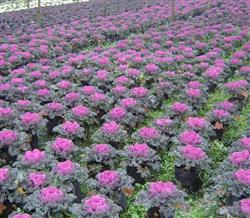How to grow kale?

How to grow kale? How should we manage and control pests? Please give guidance on kale planting methods and management methods can refer to the following techniques: seeding seedlings in late February to use protected land seedlings, about 50 grams per mu of land. Before sowing, first irrigate bottom water in the seedbed, then evenly sow seeds, and then cover with fine soil about 1 cm thick. After sowing, keep the temperature at 25℃ in the day and 15℃ at night. After emergence, cover with fine soil 1~1.5 cm, keep 20~25℃ in daytime and 10~15℃ at night. When the seedlings grow to 2~3 leaves, the seedlings are divided, and the row spacing is 6×6 cm. About 40 days after sowing, seedlings can be transplanted with soil when they have 5~6 leaves. Before planting at appropriate time, soil preparation shall be combined, and 4000 kg of decomposed circle fertilizer and 30~40 kg of ternary compound fertilizer shall be applied per mu. After ploughing and harrowing, make ridges 1 meter wide and 15 cm high (the distance between two ridges is about 30 cm), and then cover with plastic film. From late March to early April, when the local temperature reaches above 10℃, two rows of seedlings are drilled on the ridge, and the row spacing is 50×30 cm. Water and fertilizer management: irrigate enough water after planting, irrigate in case of drought afterwards, and keep soil moist frequently. Topdressing is generally carried out once every 20~30 days, and urea and potassium sulfate are applied every 10~15 kg. Spraying 0.2% Hexin liquid fertilizer in combination with spraying in growth period can promote plant health and improve yield and quality. The diseases and insect pests of collards include black spot, diamondback moth, cabbage caterpillar, aphid, etc., which can be controlled by spraying 65% multifruit 1000 times solution, 0.2% abamectin 1500~2000 times solution or 10% imidacloprid 2000~2500 times solution. Click for more cabbage growing techniques Click for more vegetable growing techniques
- Prev

How can kale be planted with seeds?
How can kale be planted with seeds? Please give detailed instructions to introduce the varieties of Brassica napus, which are native to Greece and other countries along the Mediterranean coast of Europe and have a long history of cultivation in some countries in Europe and the United States. In recent years, it was introduced from the United States, the Netherlands, Germany and other countries, in Beijing, Shanghai and other cities.
- Next

How to cultivate kale in open field?
How to cultivate kale in open field? Please introduce in detail the planting methods and management methods for open field cultivation of kale can refer to the following methods: cultivation season: generally raising seedlings in protected fields from late March to early April, planting in the open field in the first and middle of May, and harvesting in the first and middle of June. Sowing and raising seedlings 1. Sow:.
Related
- Where is it suitable to grow horseradish in China? it is expected to see the middle altitude horseradish in Alishan.
- How to prevent tomato virus disease reasonably? (Control methods included)
- Many people like to plant towel gourd on the balcony. What are the main points of this method and management?
- What crops can chili peppers be mixed with?
- Fertilization techniques and matters needing attention in Tomato
- What are the grafting techniques for peach seedlings in spring?
- Harm and control methods of root swelling disease of Chinese cabbage
- What are the pests of sweet potatoes? How to prevent and cure it?
- Symptoms, causes and Control methods of navel Rot in Tomato
- The cause of "Cucumber rotten bibcock" in Farmers' planting Cucumber and its Control Plan

